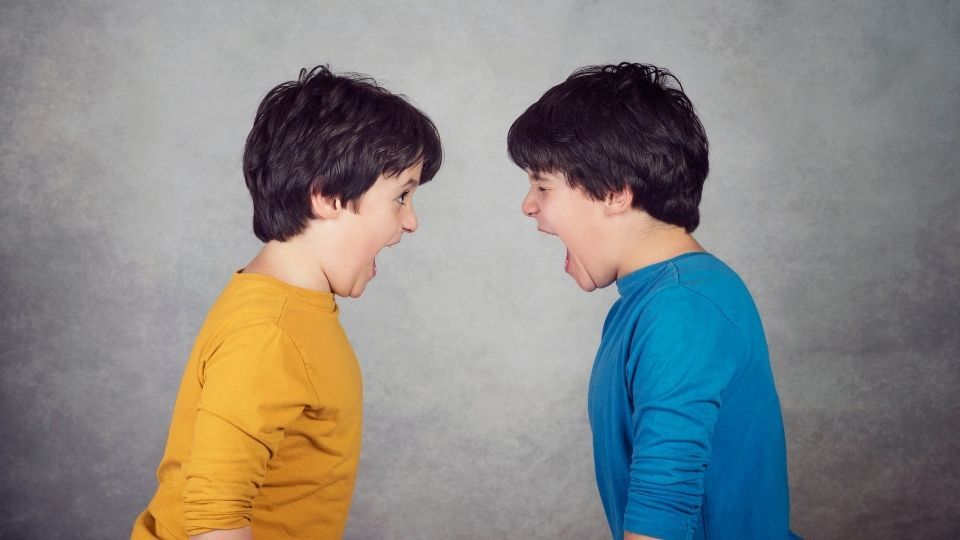Helping Children Understand and Manage Anger

Anger is a strong emotion that often leads to negative coping strategies. Indications of anger in children often include kicking, hitting, clenched fists, and a reddened face. Withdrawal, anxiety, and depression can also be indicators of anger. Children’s anger can create challenges for caregivers and stress and frustration for all parties involved.
What Is Anger?
Anger is a natural, normal emotion that is an unavoidable part of being human. It is a behavioral and emotional reaction to an unpleasant experience such as a violation of personal rights or a challenging of beliefs (Goldstein, Brooks, & Weiss, 2004; Wilde, 2000). Anger is often viewed as a negative expression of emotions, but can actually be helpful in certain situations. Feelings of anger can serve as a warning sign that an issue needs to be addressed (Wilde, 2000).
Anger is an individual experience that affects every child differently. It is a secondary emotion, often used as a defense mechanism, to protect oneself from experiencing more pain from underlying primary emotions such as fear, hurt or betrayal. Children’s feelings of anger are often based on not having needs and wants met, not feeling loved or cared for, or not receiving validation for their feelings (Green, Whitney, & Potegal, 2011; Wilde, 2000).
Anger elicits both physiological and psychological changes within the body. Physiological effects include increased heart rate, increased blood pressure, and increased hormone levels (American Psychological Association, 2007). Anger releases chemicals in the brain that prepare individuals to respond or react to potentially harmful situations, also called the “flight or fight” response. This automatic, intuitive response serves as a survival signal to the body (Allan, 2005).
Psychological effects of anger include feelings of sadness and hopelessness, often resulting in selfprotective behaviors such as avoidance or withdrawal. For others, feelings of anger can evoke aggressive, hostile, or self-destructive responses (Crockenberg & Langrock, 2001). Psychological effects of chronic anger can cause increased stress that impacts an individual’s health and interpersonal relationships, often resulting in heart disease, strokes, or social isolation (Crockenberg & Langrock, 2001; Wilde, 2000).
Although anger is a natural emotion, it is important for parents to recognize the components of anger, help children understand and manage anger, and equip children with effective coping strategies for dealing with anger.
Components of Anger
Children’s anger poses challenges for parents and other caregivers and accounts for stress and frustration for all parties involved. It has three components: feeling anger, expressing anger, and understanding emotions. Awareness of the three components provides parents and caregivers with the knowledge to guide and manage children’s anger (Berkowitz & Harmon-Jones, 2004; Smith, Hubbard, & Laurenceau, 2011).
The first component of anger consists of emotions or feelings that are experienced when needs, wants, or goals are blocked or not met (Allan, 2005). Children experience the emotional state of anger when faced with stress-producing interactions. Anger-evoking emotions may be triggered when children encounter invasions of personal space, physical assault, taunting and teasing, or rejection (American Psychological Association, 2007; Rosenberg, 2005).
The second component of anger is the action, or the way children express their anger. These expressions of anger can take on both passive and aggressive forms. Some children express their anger by crying, sulking, or talking, whereas others may physically or verbally retaliate against the situation or person. Suppression of anger is another means of expression that entails avoiding or attempting to escape the unpleasant experience. When suppression of anger is redirected and turned outward, focusing on something positive, it can be a healthy way to deal with anger. If anger is suppressed and turned inward, interpersonal relationships may suffer, which often leads to depression. Other children express their anger by seeking comfort from caring adults who help calm the child and provide a healthy solution to the incident (American Psychological Association, 2007; Smith et al., 2011).
The final component of the anger experience is understanding the emotion. Because children have limited ability to reflect upon their emotions, they lack the skills to regulate their expressions of anger (Goldstein et al., 2004). Parents and other caregivers play an important role in guiding children toward understanding and managing their feelings and expressions of anger (American Psychological Association, 2007; Smith et al., 2011).
Helping Children Understand and Manage Anger
Children must have a foundation of basic cognitive processes before they are able to develop an understanding of anger. Three key components contribute to children’s understanding of anger: memory, language, and self-regulatory behaviors (Engerud & Vikan, 2007).
Memory develops considerably during early childhood and allows children to recall aspects of anger-evoking interactions. Children often model what they have learned by watching adults and family members, including the expression of anger. When faced with anger-arousing emotions, they may recall strategies that they witnessed at an early age. If the anger management strategy was an unhelpful or aggressive one, children may need to be reminded of and given choices of more productive ways to handle their emotions (Engerud & Vikan, 2007; Goldstein et al., 2004).
Children gain an understanding of their feelings by talking about emotions. The development of language skills help children understand and label their emotions; therefore, children will have varying degrees in their ability to identify and label angry feelings. Parents and caregivers play an important role in the process of talking about emotions. Children learn to model a variety of approaches by listening to their parents and caregivers talk about emotions (Engerud & Vikan, 2007).
Emotion regulation provides children with the ability to monitor, evaluate, and modify their emotional reactions to anger in order to accomplish their goals. Selfregulatory behaviors allow children to control impulses and delay immediate gratification (Smith et al., 2011). Parents and caregivers can guide children in the development of strategies for understanding emotions associated with anger by modeling effective emotion regulation skills (Goldstein et al., 2004).
Effective Coping Strategies for Children
Children have different coping potentials, or in other words, the perceived ability to deal with an angerinducing event (Berkowitz & Harmon-Jones, 2004). Parents and caregivers can engage children in a variety of strategies to assist with their feelings of anger. For best outcomes, include children in determining strategies and solutions (Goldstein et al., 2004).
- Stop and think - Parents and caregivers can teach children to apply the thought stopping technique when faced with feelings of anger. By saying “stop” out loud or thinking it, children are given time to distract themselves from the event. Thinking of a positive or happy memory is also a useful approach when dealing with anger. Focusing on positive memories distracts children from the negative emotions that they are feeling (Wilde, 2000).
- Do something physical - Engage children in an activity that uses their entire body such as jumping jacks, running, or dancing. Children can also refocus their anger by playing with play dough or modeling clay, which can be rolled, twisted, and pulled apart. Physical activities can help children refocus their anger while providing the necessary time to calm down (Allan, 2005).
- Relax - Children often need to take a time-out to relax and regroup, and changing the environment that is causing feelings of anger can help. Parents and caregivers can have children read a story, take a relaxing bath, or draw and color a picture. By providing a calming and soothing alternative, children are able to relax and refocus (Allan, 2005).
- Talk to children - By expressing empathy and encouraging children to label their feelings, parents and caregivers can assist children in understanding their feelings of anger. Depending on the age of the child, it can also be helpful to have children draw a picture of what their anger looks like in order to help them express themselves (Wilde, 2000).
- Knowing when to seek help - It is normal for children to become upset from time to time, but parents and caregivers may find it beneficial to seek professional help. Some indicators for parents may include the struggle with ongoing and intense outbursts, leading to isolation of friends. If children are experiencing reoccurring stomach aches or headaches due to the suppression of anger, professional help may also be advantageous (Goldstein et al., 2004).
Children’s anger can be stressful and frustrating for caregivers and children; but with understanding and employing a few helpful strategies, it is possible to help children to recognize and manage their anger effectively.
References
- Allan, R. (2005). Getting control of your anger: A clinically proven, three-step plan for getting to the root of the problem and resolving it. New York, NY: McGraw Hill.
- American Psychological Association (2007). Controlling your anger before it controls you. Retrieved from http://www.apa.org/topics/controlanger.html.
- Berkowitz, L., & Harmon-Jones, E. (2004). Toward an understanding of the determinants of anger. Emotion, 4(2), 107-130.
- Crockenberg, S., & Langrock, A. (2001). The role of specific emotions in children’s responses to interparental conflict: A test of the model. Journal of Family Psychology, 15(2), 163- 182.
- Enderud, M. S., & Vikan, A. (2007). Five to seven year old children’s strategies for regulating anger, sadness, and fear. Nordic Psychology, 59(2), 127-134.
- Goldstein, S., Brooks, R., & Weiss, S. K. (2004). Angry children: Worried parents. Plantations, FL: Specialty Press, Inc.
- Green, J. A., Whitney, P. G., & Potegal, M. (2011). Screaming, yelling, whining, and crying: Categorical and intensity differences in vocal expressions of anger and sadness in children’s tantrums. Emotion, 1-10. doi: 10. 1037/a0024173.
- Rosenberg, M. B. (2005). The surprising purpose of anger. Beyond anger management: Finding the gift. Encinitas, CA: PuddleDancer Press.
- Smith, M., Hubbard, J. A., & Laurenceau, J. P. (2011). Profiles of anger control in second-grade children: Examination of self-report, observational, and physiological components. Journal of Experimental Child Psychology, 110, 213-226.
- Wilde, J. (2000). More hot stuff to help kids chill out: The anger and stress management book. Richmond, IN: LGR Publishing.
Authors
Shannon Cromwell, Extension Assistant Professor, and Naomi Brower, Extension Associate Professor
Related Research





